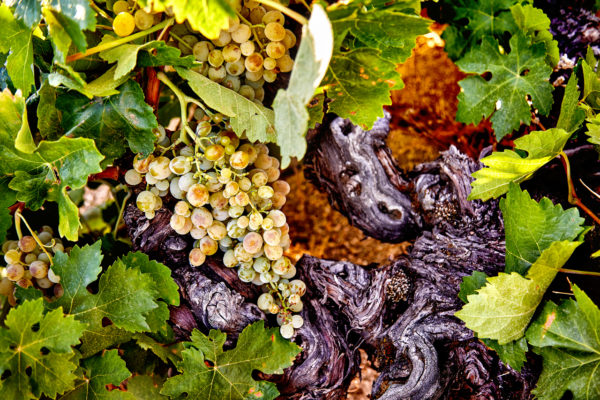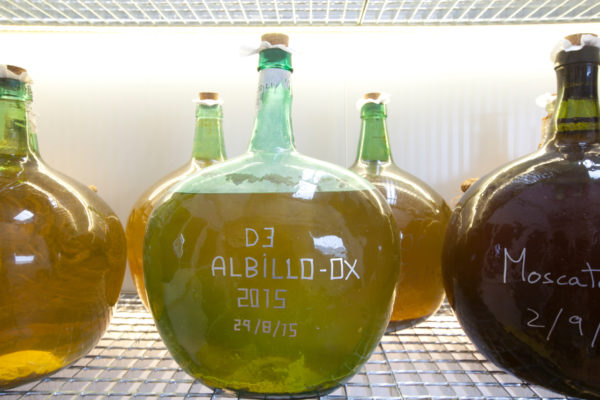

There is a lot of Albillo planted in Spain and a lot of different Albillos, so this is part one of a series we’re calling The Many Faces of Allbillo – Albillo Real.
As you might guess from the name, Albillo comes originally from the Spanish word for white. In Galicia where there is a diversity of white varieties grown, the locals took pains to differentiate them. However, in places where red varieties were far more common, those scattered white grapes vines were frequently called “the whites”, or Albillo. This means that the Albillo in the Sierra de Gredos isn’t necessarily the same as the Albillo in Castilla, the Canary Islands, or La Mancha. Complicating matters further is that there seems to be a lot of genetic diversity within each category of Albillo – as happens when a grape has been propagated in a location for centuries – and little impetus for tracing possible relationships. Basically, Albillo is a hot mess.

Albillo Real at Bodega Marañones just before harvest
This is the principal Albillo of the Sierra de Gredos. It is adapted to a warm Mediterranean climate so it buds early, is vigorous, and has a tendency to sprawl so careful pruning is vital to making successful wines. It is very sensitive to frost which is why you find it planted mainly in the warmest villages of the Gredos: Cebreros, San Martín de Valdeiglesias, Cadalso de los Vidrios, and Cenicientos. Carefully farmed, yields are quite low at 15hl/ha. When ripe, it has a deep golden color.
The structure of the wines made from Albillo Real is based on minerality more than acidity. As a result, the most successful plantings are located at a higher elevation, on sandier granitic soils that emphasize the acidity in the wines. Unfortunately, the best sites are frequently those that are most likely to suffer from late Spring frosts. So quality Albillo is a riskier proposition that few growers really embrace in a significant way. Due to its early fruiting cycle, it is quite popular with birds who see it as a source of food weeks before figs and blackberries are available.

OK, not all the Albillo Real at Bodega Marañones is made in the modern style…
Before the advent of modern winemaking, Albillo Real was a table grape or turned into oxidative styles of wine, and some old soleras of Rancio still exist in the region. Now that estates such as Bodega Marañones have started to champion the variety it has the capacity to show subtle aromas of white flowers and jasmine, possesses a medium- to full-body with peach and pear flavors, and a pleasingly and slightly bitter finish reminiscent of almonds. The best examples also have a distinctive mineral and saline character. To achieve this balance of flavors, growers have to actively farm throughout the seasons, risk preserving their oldest vines in the most inauspicious locations prone to frost, fight off the birds, and harvest right when the potential alcohol is between 13-13.5%. Lower than that and the wine tastes fairly neutral, and above that, it loses its balancing minerality.
Given all this, it is surprising that anyone still grows Albillo Real, which makes the Picarana from Bodega Marañones fairly unique in combining varietal precision and relative availability.